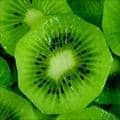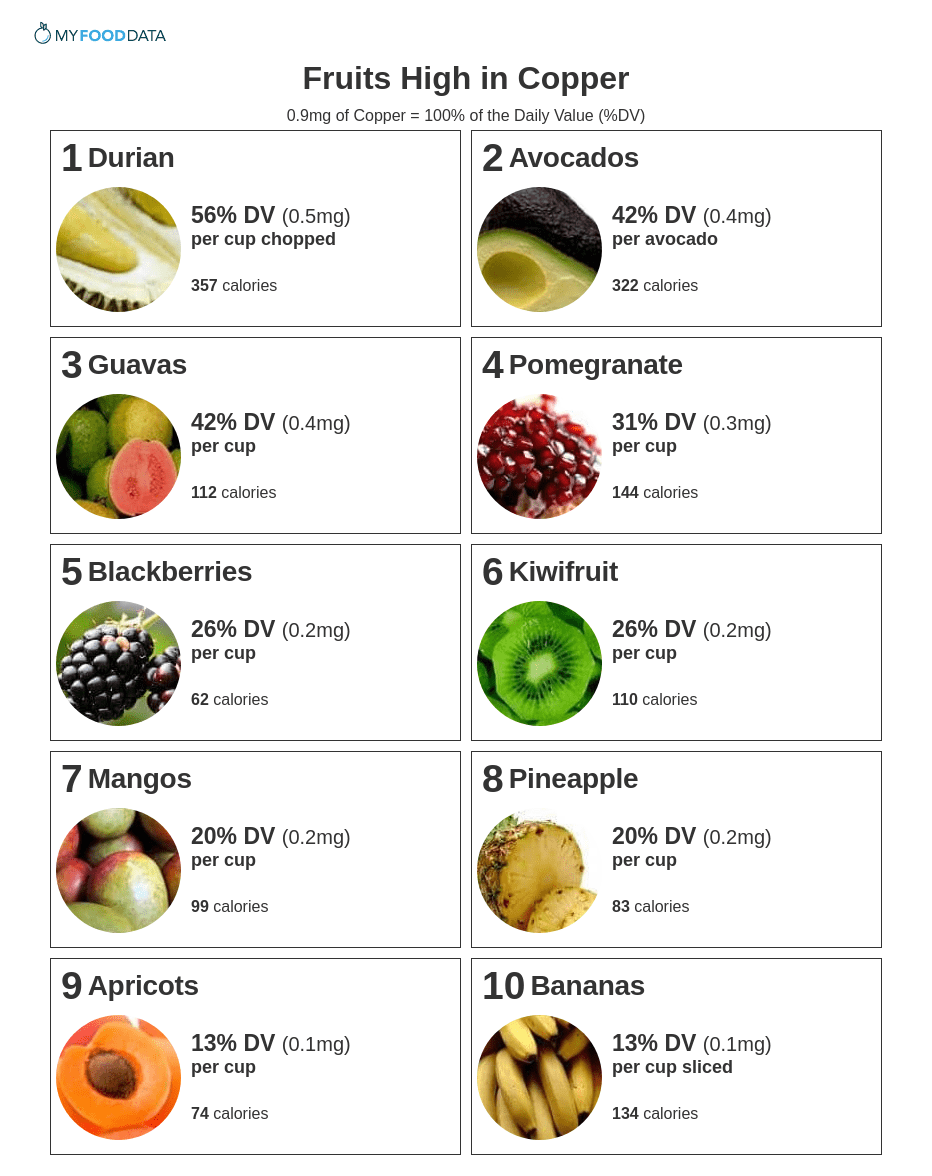Fruits High in Copper

An adequate intake of copper is necessary for a healthy immune system and healthy bones. Copper also works with iron to create blood cells and reduce the risk of anemia. (1)
Fruits can be a good source of fiber, protein, iron, and even copper.
Fruits high in copper include durian, avocados, guavas, pomegranates, blackberries, kiwifruit, mangos, pineapples, apricots, and bananas. (2) The current daily value (DV) for copper is 0.9mg. (3)
For more high copper fruits see the extended list of less common fruits rich in copper and dried fruits high in copper.
-
 1. Durian
1. Durian
Copper
per Cup ChoppedCopper
per 100gCopper
per 200 Calories0.5mg
(56% DV)0.2mg
(23% DV)0.3mg
(31% DV) -
2. Avocados
Copper
per AvocadoCopper
per 100gCopper
per 200 Calories0.4mg
(42% DV)0.2mg
(21% DV)0.2mg
(26% DV) -
 3. Guavas
3. Guavas
Copper
per CupCopper
per 100gCopper
per 200 Calories0.4mg
(42% DV)0.2mg
(26% DV)0.7mg
(75% DV) -
 4. Pomegranate
4. Pomegranate
Copper
per CupCopper
per 100gCopper
per 200 Calories0.3mg
(31% DV)0.2mg
(18% DV)0.4mg
(42% DV) -
 5. Blackberries
5. Blackberries
Copper
per CupCopper
per 100gCopper
per 200 Calories0.2mg
(26% DV)0.2mg
(18% DV)0.8mg
(85% DV) -
 6. Kiwifruit
6. Kiwifruit
Copper
per CupCopper
per 100gCopper
per 200 Calories0.2mg
(26% DV)0.1mg
(14% DV)0.4mg
(47% DV) -
 7. Mangos
7. Mangos
Copper
per CupCopper
per 100gCopper
per 200 Calories0.2mg
(20% DV)0.1mg
(12% DV)0.4mg
(41% DV) -
8. Pineapple
Copper
per CupCopper
per 100gCopper
per 200 Calories0.2mg
(20% DV)0.1mg
(12% DV)0.4mg
(49% DV) -
 9. Apricots
9. Apricots
Copper
per CupCopper
per 100gCopper
per 200 Calories0.1mg
(13% DV)0.1mg
(9% DV)0.3mg
(36% DV) -
 10. Bananas
10. Bananas
Copper
per Cup SlicedCopper
per 100gCopper
per 200 Calories0.1mg
(13% DV)0.1mg
(9% DV)0.2mg
(19% DV)
Printable One Page Sheet

Less Common Copper Rich Fruits
| Food | Serving | Copper |
|---|---|---|
| 1. Mamey Sapote | 1 cup chopped | 41% DV (0.4mg) |
| 2. Litchis (Lychees) | per cup | 31% DV (0.3mg) |
| 3. Sapodilla | per cup | 23% DV (0.2mg) |
| 4. Persimmon | per fruit | 21% DV (0.2mg) |
| 5. Jackfruit | per cup sliced | 14% DV (0.1mg) |
| 6. Nectarines | per cup | 14% DV (0.1mg) |
| 7. Plantains | per cup | 12% DV (0.1mg) |
| 8. Red and White Currants | per cup | 13% DV (0.1mg) |
| 9. Quinces | per fruit | 13% DV (0.1mg) |
| 10. Cherimoya | per cup | 12% DV (0.1mg) |
Dried Fruit High in Copper
| Food | Serving | Copper |
|---|---|---|
| 1. Dried Figs | 1 cup | 48% DV (0.4mg) |
| 2. Dried Pears | per oz | 12% DV (0.1mg) |
| 3. Dried Peaches | per oz | 11% DV (0.1mg) |
| 4. Dried Apricots | per cup | 11% DV (0.1mg) |
| 5. Dried Mango | per oz | 9% DV (0.1mg) |
| 6. Prunes (Dried Plums) | 3 prunes | 9% DV (0.1mg) |
| 7. Dried Blueberries | 1/4 cup | 7% DV (0.1mg) |
| 8. Dried Apples | per oz (5 rings) | 6% DV (0.1mg) |
| 9. Dates (Deglet Noor) | 3 dates | 5% DV (0mg) |
| 10. Dried Cranberries | 1/4 cup | 3% DV (0mg) |
About the Data
Data for the curated food lists comes from the USDA Food Data Central Repository.
You can check our data against the USDA by clicking the (Source) link at the bottom of each food listing.
Note: When checking data please be sure the serving sizes are the same. In the rare case you find any difference, please contact us and we will fix it right away.
About Nutrient Targets
Setting targets can provide a guide to healthy eating.
Some of the most popular targets include:- Daily Value (%DV) - The daily value (%DV) is a general guideline for consumption that will prevent deficiency of a particular nutrient in most people. The %DV refers to the percentage of an amount that\'s found in a single serving of a food. It also accounts for absorption factors. It is set by the U.S. FDA.
- Recommended Dietary Allowance (%RDA) - The RDA sets an average daily dietary intake level that is sufficient to meet the nutrient requirements of nearly all (97.5%) healthy individuals. It\'s more specific than the daily value, and varies by age and gender. The RDA is set by the US National Institutes of Health.
- Reference Dietary Intake (%RDI) -The reference dietary intake is similar to the recommended daily allowance, but is specific to age and gender. The RDI for amino acids is set by the U.N. World Health Organization.
- Adequate Intake (%AI) - This value is primarily used in reference to omega-3 and omega-6 fats. The Adequate Intake is set by the U.S. Institute of Medicine. Because there is less evidence to determine the ideal targets for consumption of these nutrients, the specific amount is considered to be less reliable. Using the term Adequate Intake, rather than one of the other terms, helps to emphasize that the ideal intake of that particular nutrient has not yet been scientifically determined.
See the Guide to Recommended Daily Intakes for more information.
Want to set your own targets? Sign up for an account and set custom targets in the daily food log.From the Nutrient Ranking Tool
Use the ranking tool links below to select foods and create your own food list to share or print.
- Foods High in Copper
- Foods Low in Copper
- Vegetables High in Copper
- Fruits High in Copper
- Vegetarian Foods High in Copper
- Nuts High in Copper
- Grains High in Copper
- Beans High in Copper
- Dairy High in Copper
- Breakfast Cereals High in Copper
- Fast Foods High in Copper
View more nutrients with the nutrient ranking tool, or see ratios with the nutrient ratio tool.
Related
Data Sources and References
Try the recipe nutrition calculator, or daily meal planner.
Create a free account to log and track foods.

 Next ➞
Next ➞